This document summarizes a study on food insecurity among women in Saskatchewan. It provides background information on definitions of food security and insecurity. Food insecurity can be experienced at the individual, household, community and cultural levels. It then outlines the study's methods of interviewing women in rural, remote and urban areas of Saskatchewan. Key findings included the stigma of food insecurity, its physical and mental health impacts, and challenges with access, affordability and approaches to nutritious food. The conclusion discusses implications for public policy around income support and food security.
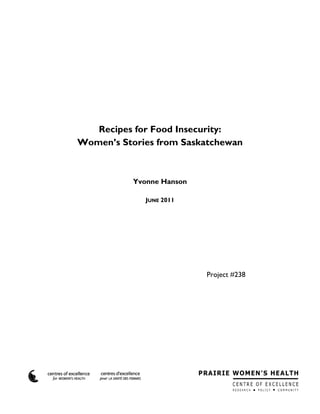
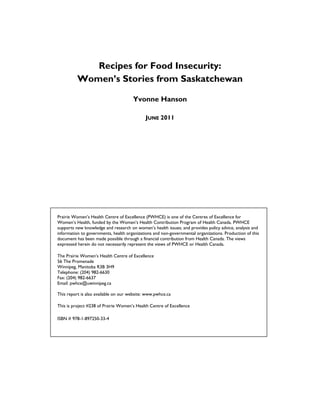
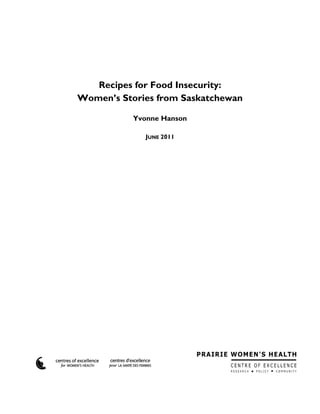

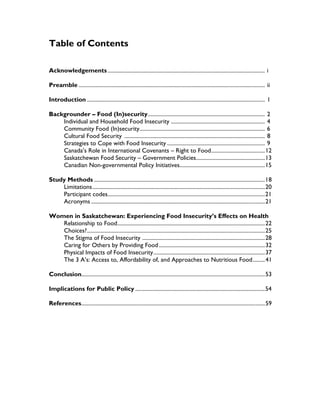





![Recipes for Food Insecurity: Women’s Stories from Saskatchewan 1
Introduction
Inside the borders of Canada rising concerns have been sparked by a number of circumstances
resulting from a now globalized, commodity-based agri-food system(s). Some of the
dimensions of these concerns stem from: trickle-down effects of global food markets (e.g.
export-based production), food safety (e.g. Listeriosis outbreaks), genetic engineering in food
supply chains, and epidemic-scale health consequences associated with food intake, such as
obesity and diabetes. Food insecurity occurs when agri-food systems fail to secure
individuals, households and communities their right to healthy and culturally-appropriate food
that is grown in ecologically-sustainable ways.
Food crosses more disciplinary boundaries than almost any other topic including: agriculture,
environment, health, governance, culture, religion, transportation, trade and economy, and
education. Not surprisingly, food also has many intersections in a culturally defined sexual
division of labor and gender assumptions. Discussions on food insecurity and the
“individual’s right to food takes place within the context of households, [which is] often out of
sight of those concerned with food policy and household food security” (Van Esterik, 1999,
p.225). Women’s traditional relationships to food production, purchasing and preparation, and
their socialized role in “caring” for family members aptly positions them to comment on the
competence of food policy in creating and maintaining healthy communities and households.
In Canada, “unattached” women and single mothers with children are prominently represented
in food insecure populations or those considered “at-risk” of food insecurity. Furthermore
more than half of Aboriginal women living off-reserve, heading households with children are
food insecure (Statistics Canada, 2006).
This study was designed to provide some gendered understanding of food insecurity among
women in three communities in Saskatchewan, from rural, remote and urban locations. The
study is significant in two ways: 1) it explored Saskatchewan-focused food security policy and
initiatives through a gendered lens, which is a rare occurrence in research literature; and 2) it
provides an avenue for women to share their stories and opinions on how food insecurity
affects their health and well-being. This final report is a summary of those two objectives.](https://image.slidesharecdn.com/ebe21aec-c139-40fd-bb88-3835a99f64a5-161118194105/85/RecipesForHunger_2011_Hanson-11-320.jpg)

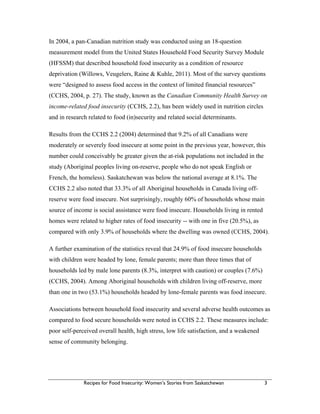

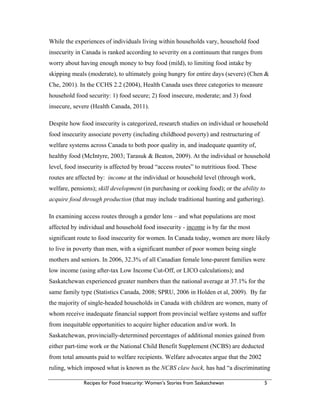



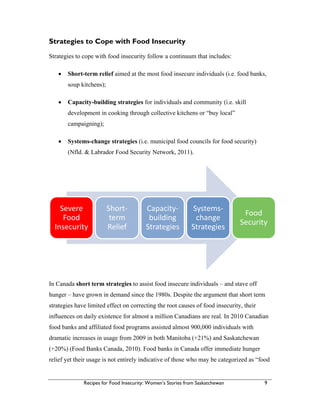
![10 Recipes for Food Insecurity: Women’s Stories from Saskatchewan
insecure”. It is estimated that approximately one-third of Canada’s food insecure
population access food banks (McIntyre, 2003). Short-term strategies like food banks
were envisioned as a “stop-gap” measure to coincide with the elimination of child
poverty in Canada by 2000, however, the reality of their growth indicates escalating
income disparities and greater numbers of food insecure people in Canada.
Capacity building strategies stem from an alternative agri-food movement which
“places greater emphasis on environmental concerns, multiple disciplines [like social
wellness, health, economy, governance] and whole-systems approaches” (Allen, 2004)
versus a traditional approach to agri-food production focused on harnessing nature,
through science and technology, to produce food. Capacity building strategies include:
community-supported agriculture (CSA), collective kitchen development, community
gardens, buy-local campaigns, good food boxes and similar types of initiatives. These
initiatives are largely coordinated at the local level with the support of community
organizations that have combined social justice and food security goals.
In addition to their current benefit to food security initiatives, “strengthened community
capacity is considered an investment in long-term success as it may increase the
potential of the community to address not only a current problem, but others that may
be identified in the future” (Hawe in NSNC/AHPRC, 2004, p. 5). Capacity building
strategies team up with the notion of community food security as discussed earlier and
the more intentional discourse of governance, democratic control and support for
farmers that food sovereignty emphasizes.
The constructs of change seem agonizingly slow within systems change strategies
where agri-food policy exist in places of federal and provincial government departments
inside Canada. Change at the municipal level has seen some advances in larger cities
like Toronto and Vancouver through the development of multi-stakeholder food policy
councils which represent the diverse contexts of and interests in food.
At the federal level, beginning with the 1948 U.N. Declaration of Human Rights to
which the right to food was a part, Canada has signed onto six international covenants](https://image.slidesharecdn.com/ebe21aec-c139-40fd-bb88-3835a99f64a5-161118194105/85/RecipesForHunger_2011_Hanson-20-320.jpg)





![16 Recipes for Food Insecurity: Women’s Stories from Saskatchewan
public good. As such it can once again assume its central role in strengthening
communities, ecosystems and economies [by] emphasizing that people must have a say
in how their food is produced and where it comes from” (PFP, 2011, p. 9). However,
implementation for federal and/or provincial governments to create public policy that
embraces food sovereignty as core values have been off-set by agri-food corporate and
global trade interests and influence (McIntyre, Thille & Rondeau, 2009). Additionally,
women’s voices have been lacking in agri-food policy developments. Roppel,
Desmarais, and Martz (2006) note that,
“While women play a critical role in the day-to-day operation of Canadian
farms and the Canadian government have committed to achieving gender
equality at all levels of decision making, there has been no explicit effort to
identify farm women’s policy needs or their vision of an inclusive Canadian
agricultural policy . . . . Women’s vision in agricultural policy rests on four
[necessary] pillars: financial stability, domestic food policy, safe, healthy
food and environment, and strengthening the social and community
infrastructure” (p. 76).
Women and food insecurity in Canada has been studied by a number of key authors
(Hamelin, A., Habicht, J.P. & Beaudry, M. (1999); Ledrou and Gervais, 2005;
McIntyre, L., Glanville, T., Raine, K., Dayle, J., Anderson, B. & Battaglia, N. (2003);
McIntyre, L. & Rondeau, K. (2009); Tarasuk, V & Beaton. (2009); Van Esterik (1999);
Vozoris, N. & Tarasuk, V. (2003); among others). These important studies allow for a
deeper understanding of food insecurity’s role in women’s lives and a deeper
connection to the multifaceted way food insecurity occurs for people. The following
few paragraphs give a snapshot into some national and provincial food
sovereignty/security policy documents, prepared by non-governmental organizations,
where gender has been considered.
In 2008 the National Assembly of Food Secure Canada launched the People’s Food
Policy Project (PFPP) where 3500 Canadians were consulted over a two year span
about what a Canadian food policy might entail. The result of those consultations is](https://image.slidesharecdn.com/ebe21aec-c139-40fd-bb88-3835a99f64a5-161118194105/85/RecipesForHunger_2011_Hanson-26-320.jpg)




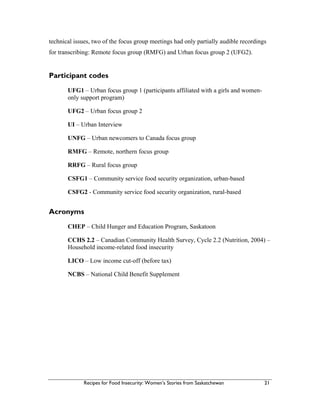
![22 Recipes for Food Insecurity: Women’s Stories from Saskatchewan
Women in Saskatchewan: Experiencing Food Insecurity’s
Effects on Health
“We are food: we eat food, we are made of food, and
our first identity, our first wealth, our first health
comes from the making, creating, giving of good food”
(Shiva, 2007, pp 35-36)
Relationship to Food
Food has long been associated with our social lives, our cultural identities, our health
and well-being, and our relationship to the land. Women’s dominant role in food
production, preparation, purchasing and food meaning has been entrenched in virtually
all societies. Although the domestic roles in Canadian families are not static, women are
(still) frequently more responsible for the unpaid, domestic and invisible work of
feeding the family (deVault, 1991).
The women consulted for this study were predominantly responsible for the majority of
cooking, organizing food budgets (in accordance with other bills and payments) and
obtaining food (grocery store purchasing or food banks) for their households. They also
worried about food and placed their needs after other family members’ food
requirements. In some conversations – particularly with urban women who were
severely food insecure – the representation of food was more about sustenance versus
enjoyment or social fulfillment as might be present among food secure individuals and
households. One woman noted that for her, “food is [merely] a filler” (UFG 2). Another
woman noted, “Some of the fruits and vegetables that you buy, you have to make sure
you have your basics before you consider buying likes grapes or plums or watermelon.
For us to have those things in our family it has got to be a birthday celebration; it’s not
something that you can go in and buy everyday” (UFG1). The reference to “basics” in
this quote was related to bread, pastas, proteins (i.e. meat or eggs) and milk.](https://image.slidesharecdn.com/ebe21aec-c139-40fd-bb88-3835a99f64a5-161118194105/85/RecipesForHunger_2011_Hanson-32-320.jpg)
![Recipes for Food Insecurity: Women’s Stories from Saskatchewan 23
Women living in the remote, northern community maintained a close relationship to
what might be referred to as a traditional diet despite some women’s acknowledgement
that consumption of these foods has changed from times when they were young. “A
traditional diet consist[s] of roots, plants, berries, fish, birds, eggs, and meat. The same
concepts apply today as did for our ancestors. A balance of healthy foods in our diet,
along with physical activity, can reduce the risk of some disease” (Abrametz &
Tshigerl, 2009). “Sometimes we get food from the store and sometimes we eat fish and
moose and berries and things like that . . . . A lot of people collect blueberries in the
summertime and cranberries” (RMFG). It was estimated that in the community where
the northern focus group was held, approximately one-third of most foods consumed
were traditional foods. The women spoke about eating fish, moose, duck, berries, and
bannock as typical foods in their daily diets.
The CCHS 2.2 (2004) reports that food security speaks to the availability of traditional
or culturally-conditioned foods individuals choose to eat as either a part, or mainstay, of
their diet. As such, the complexity of food involves more than adherence to dietary
needs in human life; it is also defined by its historic, social, cultural and spiritual
meaning as well, adding to an understanding of cultural food security as discussed
earlier (Powers 2008).
Women in the newcomers to Canada focus group (refugees, landed immigrants and new
citizens) - and the four men who were included due to culturally-appropriate reasons -
noted that daily consumption of cultural food was very important to them in holding
onto their identity. The comparison of fresh versus frozen and/or processed foods was
disturbing in the Canadian diet they perceived. “Over there we eat lots of food and we
do not become bigger and here we eat a little bit and we get bigger and bigger”
(UNCFG). Some of the individuals lamented that they carry more weight than they used
to, attributing this to Canadian sedentary lifestyles and high-fats and sugars in the diet.
“Here food is culturally different . . . . Since five years ago when I came to
Saskatoon I feel that the food tastes different here because in my home in](https://image.slidesharecdn.com/ebe21aec-c139-40fd-bb88-3835a99f64a5-161118194105/85/RecipesForHunger_2011_Hanson-33-320.jpg)
![24 Recipes for Food Insecurity: Women’s Stories from Saskatchewan
[country] or [country] the food tastes better than here just because
everything is frozen here but over there it is much more fresh” (UNCFG).
For some participants it was painful to see their children reject cultural foods in favour
of a new, Canadian diet. For the women who were newcomers to Canada, who
predominantly do all food preparation and cooking in the home, multiple meals are now
being requested, adding to an already-stretched work burden and financial resource
base. Women expressed that they were working double-time to fulfill both their cultural
food preferences and their children’s attempts to “fit into” Canadian society through
food. The cost of food and their work to prepare two diets was stressful.
“Our children they come out from their country and they are small children
and they adapt to different types of foods from different countries. So
[when] they come here they like what mama gives them [but later] they
mostly don’t care for what their mother gives them . . . that’s why our
children are completely different” (UNCFG).
“I am cooking fresh . . . but my boys sometimes they ask me, “We like
spaghetti but not our style but the Canadian’s style. I don’t cook the same.
Now that they have become Canadian and for school lunch they like a
Canadian diet – every day I am cooking vegetables for them but they like
Canadian food” (UNCFG).
“Every two days I cook rice and meat and my boys came home from school
and they saw the food and they said, ‘Oh mama I’m not hungry’ and I said
‘Oh my god. You must be hungry because I’m not making a big lunch for
them’ . . . . It’s because I don’t know how to cook Canadian food”
(UNCFG).
In discussing food with participants in the remote northern community, similar
contentions were made about the food that children ate, in drifting away from a cultural/
traditional diet. Powers (2008) notes that one aspect of cultural food insecurity “fits
with the general observation that younger people eat less country/traditional food than](https://image.slidesharecdn.com/ebe21aec-c139-40fd-bb88-3835a99f64a5-161118194105/85/RecipesForHunger_2011_Hanson-34-320.jpg)
![Recipes for Food Insecurity: Women’s Stories from Saskatchewan 25
older people [in exchange for market available foods]” (p. 96). During a discussion on
intake of traditional foods, this comment came up,
“It depends on the family but sometimes they give their kids money to buy
junk food. And they have some small stores [in the community] and they
sell lots of junk food. The kids go ask the parents for money to buy chips
and drinks. I don’t do that. They don’t want to eat nutritious food; they just
want to eat junk food” (RMFG).
When asked if people in the northern community would have eaten the same foods now
as when they were growing up, two younger women commented “Everything seems to
be changing” (RMFG). The identity that food represents in this community, like the
urban newcomers group, seems to be shifting away from traditional/cultural foods to
more market-based foods. This may have consequences yet to be fully realized in both
of these communities, not only for physical health, but cultural identity and belonging.
Choices?
Food habits and eating preference, as a conditioned and socialized behaviour, was
expressed by one participant in this way:
For myself I have been doing well, but by the time you can start affording
good, healthy nutritious food, they [your kids] are at this older age like
13,14,15, 12, 11; it is already like they have started to become accustomed
to bad food. So that by the time you can afford to introduce them to good
healthy meals – like squash and spinach and all of that kind of stuff and the
environment that you live in while they are younger is hard to grow out of
when they’re older. So they have already developed a habit, they have
already acquired a taste for fast food, high starchy food and then trying to
re-learn a new food is really difficult” (UFG1).
As evident from this participant’s story, forming healthy relationships to food was
complicated by the fact that she and her family were more severely food insecure during](https://image.slidesharecdn.com/ebe21aec-c139-40fd-bb88-3835a99f64a5-161118194105/85/RecipesForHunger_2011_Hanson-35-320.jpg)
![26 Recipes for Food Insecurity: Women’s Stories from Saskatchewan
her children’s early ages - a time best suited to develop healthy eating habits and food
preferences.
In food insecure households, “food supplies are more limited and individuals have less
varied diets, less consumption of fruits, vegetables, and milk products, and lower energy
and nutrients intakes in the context of . . . food insecurity” (Tarasuk, McIntyre, Li,
2007, p. 1980). Additionally, where income is the core inhibiting issue to food insecure
households, “diets [tend to be] high in inexpensive, energy-dense foods but low in fruits
and vegetables [and is] likely the norm” (Tarasuk, McIntyre & Li, 2007, p.1985). Other
reasons expressed by women as to why fruits and vegetables were not purchased as
commonly as other foods included: perishable foods do not last as long in storage (and
therefore can be a waste of money if not consumed); stores didn’t carry them (in urban
core area and remote communities in particular); and, do not always have time or desire
to cook, thus relying on cheap fast food or processed foods.
In the community services focus group, one staff commented, “the McDonald’s meal is
cheap and it has seduced us into thinking it is wonderful. Sometimes the smell of
French fries is just heavenly right? . . . . The other day I started my car and on the radio
they said that McDonalds had dropped off chicken nuggets with cranberry sauce and it
was very delicious, meanwhile not really thinking that they are promoting unhealthy
lifestyles!” (CSFG1)
From a slightly different angle two women from separate focus groups commented on
the monotony of eating diets with limited food choices in being food insecure. One
woman noted,
“I won’t eat deer anymore. I ate too much of it and now I can’t stand it. Or
tuna fish because tuna fish was really cheap so it was part of our school
lunch all the time. It’s so hard to eat tuna fish today because I ate too much
of it back then” (CSFG1).](https://image.slidesharecdn.com/ebe21aec-c139-40fd-bb88-3835a99f64a5-161118194105/85/RecipesForHunger_2011_Hanson-36-320.jpg)

![28 Recipes for Food Insecurity: Women’s Stories from Saskatchewan
found it difficult to maintain foods’ freshness therefore charged high prices as a great
deal of fresh food tended to spoil within a few days. As a result, residents are required
to spend extra money on transportation to the closest grocery store or compromise
healthy food choices for what is available at local convenience stores. In the remote
community where women needed to travel one and a half hours by car to obtain fresh
foods, travel in winter and during times of weather extremes imposed danger and worry.
Poor health outcomes are virtually undeniable for residents living in food deserts,
manifesting into chronic physical conditions like obesity, diabetes and hypertension.
Situations can become particularly complicated for women who have dietary restrictions
or needs relating to poor health or disease. Income such as welfare and disability impose
added barriers on top of limited choice. “As a diabetic you’re supposed to stick to the
complex carbs, which are already pricier than the regular carbs. . . then I am on pills for
my high blood pressure and diabetes and because I don’t have a health plan I have to buy
all the pills . . . my high blood pressure pills [alone] are $60 a month . . . it is depressing”
(UI).
The Stigma of Food Insecurity
Food banks cover only a portion of those affected by food insecurity. Yet, in Canada for
the month of March 2010, almost 900,000 people were assisted by food banks, a jump
of 9.2% from the previous year’s count and the highest count in recorded history
(Hunger Count 2010). In the same month, Saskatchewan food banks assisted 22,662,
which was a 20% increase from the previous year; the second-highest percentage rise in
food bank use in Canada (Manitoba was higher at 21%). At the Saskatoon Food Bank,
approximately half of the total numbers of adults using food banks were women in 2010
and almost half of all food bank users were children (Hunger Count 2010).
Although food banks attempt to provide a portion of fresh foods, they are ill-equipped
to distribute large quantities of fresh foods due to storage and refrigeration issues, and
the fact that a significant portion of foods are donated goods with longer shelf lives. A
number of women commented on the use of food banks and related types of charitable](https://image.slidesharecdn.com/ebe21aec-c139-40fd-bb88-3835a99f64a5-161118194105/85/RecipesForHunger_2011_Hanson-38-320.jpg)
![Recipes for Food Insecurity: Women’s Stories from Saskatchewan 29
services (Friendship Inn, soup kitchens) regarding the stigma attached to using them,
the shame they felt going there, the lack of nutrition in distributed foods, and the
discomfort of going to a place where violence sometimes occur. “I don’t like to go there
with my kids especially ‘cause I know that there’s going to be a fight. It’s not safe for
women with kids” (URG1). Other women were reluctant to discuss negative aspects of
charitable food sourcing as “they are really kind [there] even if the food is not that
nutritious” (UFG2).
The food bank in the rural community – which distributed food hampers once a month
out of a church basement – struggled with the community’s lack of confidentiality for
users.
“There was somebody who actually followed someone from the grocery
store to see if they were going to get a food hamper. Imagine that! ‘Them
getting food there and I don’t think you really need it’ and this got back to
me and I was just furious – what business is it of yours; that’s just an
invasion of privacy” (CSFG2).
When asked how one participant, a single woman living alone on disability insurance,
felt about going to the food bank she said,
“I feel ashamed. A woman, like, people look at you weird. The stigma – east
side, west side – we’re a division [in Saskatoon]. You have to go to the food
bank? And I say, ‘Yes, I do. Do I have any choice in the matter?’ And they
say, ‘Oh’ . . . . It’s gone – my security left. I feel like I’m struggling and I’m
starting over. I’m doing the best I can with what I have . . . . I want to get a
steel bat and a post so I can go hit something – I really, really do. I’m used
to donating to the food bank, not using it” (UI).](https://image.slidesharecdn.com/ebe21aec-c139-40fd-bb88-3835a99f64a5-161118194105/85/RecipesForHunger_2011_Hanson-39-320.jpg)
![30 Recipes for Food Insecurity: Women’s Stories from Saskatchewan
“Going to the Food Bank – Shocked!!!”
© Photovoice Saskatoon project (2006) “Looking out/Looking in: Women, Poverty and Public Policy”
(Saskatoon Antipoverty Coalition and Prairie Women’s Health Centre of Excellence)
The frustration of living alone, on limited income, without personal supports, and/or
coping with a social stigma that you are a burden to society, created a range of emotion
for women. Women voiced their anger towards a society they felt persecuted them for
being any combination of the following: poor, Aboriginal, single, overweight, renter,
living in Saskatoon’s west side, living in Saskatoon’s east side, living on a reserve,
having a car, not having a car, or speaking another language other than English. In
short, many women felt they were persecuted for just living.
“Women [in this area] usually get minimum wage and men will get prime wages
because Saskatchewan is built around men. I am not trying to sound sexist but you can’t
help it. It ticks you off after awhile, you know?” (RRFG)
Women discussed the range of how food was obtained in different geographic regions.
In urban settings food insecure women were more likely to make use of a food bank or
affiliated food program than the other two geographies; partly due to the fact that the
remote community did not have one and in the rural area the food bank was not well
known. One woman found out about the rural food bank only during the focus group](https://image.slidesharecdn.com/ebe21aec-c139-40fd-bb88-3835a99f64a5-161118194105/85/RecipesForHunger_2011_Hanson-40-320.jpg)
![Recipes for Food Insecurity: Women’s Stories from Saskatchewan 31
discussion. Still, lack of anonymity in rural areas versus urban areas may be a deterrent
to using local food banks or charitable food programs. Women from the remote
community noted, “We still share what we have with other families so if someone is
starving then we share what we have” (RMFG).
Other women talked about the loneliness of walking into a store with little money for
purchasing food or the feelings associated with not being able to buy healthy food
because of low income.
“There’s ‘living pay cheque to pay cheque’ but I think with women it’s hand
to mouth because I know I never make it to the next pay cheque and I don’t
go anywhere. I don’t eat at restaurants, I don’t treat myself to anything. I
buy second hand clothes. I do all the things you have to do and I don’t know
how many times a week I’m making baking powder biscuits or making
bannock [just] to fill up . . . . In Ireland it’s potatoes and here it’s bread”
(RRFG).
“There’s an awesome Farmer’s Market that’s on the west side, state of the
art, but not affordable for anyone who lives in this community, not one
person. I’m about three blocks away from the Farmer’s Market and I went
there and the only thing I could afford to buy was a bag of cucumbers and
that was in a zip-lock bag; like about six cucumbers. So even if we wanted
to eat healthy we can’t – they’re not allowing us to” (UFG1).
Participants were sensitive to the restrictions low income and poverty placed on their
lives. Women talked about the demands for tight budgeting and how experiencing food
insecurity is saturated with feelings of deprivation and frustration. Indirectly and
directly, women talked about the inequities in society where some people were offered
food stores nearby while others had no healthy, affordable options within a 1-kilometre
radius. Urban participants noted this contradiction most profoundly and questioned how
governments could allow this to happen.](https://image.slidesharecdn.com/ebe21aec-c139-40fd-bb88-3835a99f64a5-161118194105/85/RecipesForHunger_2011_Hanson-41-320.jpg)
![32 Recipes for Food Insecurity: Women’s Stories from Saskatchewan
Caring for Others by Providing Food
Many women who participated in focus group meetings spoke of the ways food
insecurity made them feel, particularly in the way food insecurity defied how they have
been socialized to care for others.
“I am happiest when I make food for my kids. But I am also sad to know it’s
not always the kind of food I know they need” (UFG 2).
“I know how it feels to have an empty stomach and I don’t like seeing
[other] people with an empty stomach” (CSFG1).
“I’m lucky I have a car . . . . I should have brought my neighbour here –
she’s a single woman who has serious mental problems and can’t get work
and she gets $302 a month. No vehicle, no help and no community support.
And people say, ‘Oh never mind that’s just Carol.’ What do you mean that’s
just (name)? She’s hungry too. Look at how skinny this woman is! She’s
twiggy skinny but on the other hand I can’t afford to help her and I feel
awful. When I’m eating I feel guilty when she walks by my window because
I can’t offer her any food because I’ve made my one potato and one chicken
leg and no veggie. And it’s difficult!” (RRFG)
DeVault (1991) describes women’s involvement in the role of caring as part of the
social organization where gender norms for behaviour are established. In many focus
group meetings women spoke about their socialization in fulfilling the caregiver role
(i.e. learning as girls to cook then feed others first, looking after children, etc) and how
food insecurity compromised or added challenges to this role. For some women whose
lives were enhanced by caring for others which included food provision, food insecurity
affected both their psychological and social well-being (see Table 1, p. 6), through the
stresses of not being able to provide adequately and the inability to live up to expected
gender roles of sharing food with others.
In a study that explores a farm women’s discourse on food provisioning and healthism,
McIntyre, Thille & Rondeau (2009) found that “when considered with their gendered](https://image.slidesharecdn.com/ebe21aec-c139-40fd-bb88-3835a99f64a5-161118194105/85/RecipesForHunger_2011_Hanson-42-320.jpg)
![Recipes for Food Insecurity: Women’s Stories from Saskatchewan 33
role, [women] assumed the position of family guardian from negative health
implications such as fatness, chronic illness and early death . . . [and] their gendered
role carries the consequences . . . that blames mothers/wives for the health problems of
their families” (p. 92). This viewpoint is entrenched within a Canadian dominant value
system that perceives women as ultimately responsible for feeding their families
thereby diverting responsibility away from the state (vis-à-vis health promotion and
public policy) and onto individuals (women). If examining healthism through a
combined gender and food insecurity lens, when family structures are viewed in terms
of individual units rather than part of a larger social cohesion, women as caregivers
become targets to blame rather than the state. Women, in traditional caregiving roles
may as well, assume blame for any poor health of individual family members based on
the food she provides. Thus food insecurity, due to inability to provide healthy food for
family members, objectifies the role of ‘women as caregiver’ in scrutinizing ways.
One staff in the community service focus group had a unique perspective on the role of
caring and women. She felt that women’s gendered role to care had another side where
women needed social acceptance by making people feel happy, unintentionally to the
detriment of nutrition in diets.
“I think there’s an area that women - because they are often in charge of
cooking - want to please the people who are eating. They themselves have
their own food preferences, so when you say low cost and low price diets
are often higher in salt, well salt seems to make any food taste better. It
makes your taste buds burst! And I think sometimes women are guilty of
wanting to please others so they prepare what they know others will [like].
Like the women who will prepare Kraft Dinner - we could say she could
buy whole wheat spaghetti and canned tomatoes and serve a similar meal
cheaper and healthier than Kraft Dinner . . . . We’re also busy and we have
other things we would prefer to do . . . . I want to challenge myself as a
woman from the ‘baby boomers’ and we opted out of the kitchens and
didn’t value the [goodness] of food, we wanted Cheez Whiz and packaged](https://image.slidesharecdn.com/ebe21aec-c139-40fd-bb88-3835a99f64a5-161118194105/85/RecipesForHunger_2011_Hanson-43-320.jpg)

![Recipes for Food Insecurity: Women’s Stories from Saskatchewan 35
they know this to be to their own health detriment. It seems that many of the women
were socialized to view food intake this way.
“When I was growing up I lived with my grandparents and they were all
together so when it was time to eat - and the girls always had to cook or
clean -so always it was the guys who ate first. So if you were cooking then
you were the last to eat because everybody had to eat then the guys would
come in from work and eat first then the kids and then the women after
everybody” (RRFG).
Another woman noted, “But how many times have you said when there’s not enough
‘Oh I’m not really hungry’ and you let it go?” (RRFG).
One young woman, eighteen (18) years old, who attended a focus group with her
mother, indicated, “When I was living at home I would mostly feed other people and
not me. I would concentrate on my brothers to make sure they were fed . . . . I don’t
have lunch. I don’t eat until supper.” Her mother indicated that her daughter was her
back-up support; someone whom she could trust.
“I am trying to find the money to pay the rent, the power [bill], the energy
[bill], whatever. And trying to meet those needs and because I don’t have a
reliable partner the next person I could depend on was my daughter and she
is very, very over-protective over her brothers. She was [my] right-hand
woman” (UFG2).
Consistent with a study on food insecurity and mothers in Atlantic Canada, McIntyre et
al. (2003) found that “low income lone mothers are compromising their own diets in
order to preserve the healthier diets of their children . . . . The implications for the
nutritional health of women living in poverty are grave and go beyond the nutritional
risks associated with their reproductive role” (p. 691). A further study by Collins (2009)
found that income-related food insecurity negatively affected mothers’ mental health
such as: anxiety, stress, worry, guilt, irritability and shame. In this study on food](https://image.slidesharecdn.com/ebe21aec-c139-40fd-bb88-3835a99f64a5-161118194105/85/RecipesForHunger_2011_Hanson-45-320.jpg)
![36 Recipes for Food Insecurity: Women’s Stories from Saskatchewan
insecurity among Saskatchewan women, feelings of depression, worry, shame, guilt,
anger and fatigue were similarly expressed.
Unattached women without children in the study noted a different kind of stigmatization
where traditional values placed importance on heterosexual relationships and families
with children versus non-children families. In particular, women in rural focus groups
talked about the stigma attached to being single. They felt that their position in society
was perceived as a burden to the community through the fact they were women, did not
have (young) children, and were not interested in a partnership with a man. One rural
woman noted,
“They [community members] frown on me and they think there’s something
wrong with me because I’m single . . . . Where I live there is a little bit of a
mentality that single women get pushed aside so if there are jobs they go to
married women [first] because we are seen as unreliable women . . . . As a
single woman it’s just decided that I must not be worth anything because
there is only one of me . . . . It’s just the whole mentality and it’s really sad.
I can’t wait until they catch up with the rest of Canada” (RRFG).
“If a man becomes single, for whatever reason, they become part of the
[rural] culture because they go golfing together, they play cards together,
they go to the bar together. There’s a lot of things they do together and as a
single woman there aren’t really groups like that where you can do things
together . . . . There’s not really a culture for women here at all. I had been
married in the community for a long time and had a very active social life
and then [when my husband died] I went to not having any friends here at
all” (RCFG).
The vulnerability for “unattached” women was evident in urban areas too. One single
woman without children, whose personal circumstances declined after a serious
pedestrian-auto accident left her physically disabled, found herself without sufficient
income to meet her basic needs. A combination of inability in working full-time due to](https://image.slidesharecdn.com/ebe21aec-c139-40fd-bb88-3835a99f64a5-161118194105/85/RecipesForHunger_2011_Hanson-46-320.jpg)


![Recipes for Food Insecurity: Women’s Stories from Saskatchewan 39
“The Right to Food”
© Photovoice Saskatoon project (2006) “Looking
out/Looking in: Women, Poverty and Public Policy”
(Saskatoon Antipoverty Coalition and Prairie
Women’s Health Centre of Excellence)
indicative of “binge eating” is attributed to rising obesity rates particularly as they relate
to women (Che & Chen, 2001). With food insecurity, periods of insufficient foods
promotes a pre-occupation with food potentially resulting in food disorders causing
overweight and obesity, particularly among women.
In this study, participants noted
particular health issues present in
their lives that may have resulted
from unhealthy food intake: diabetes,
low blood pressure, hypertension,
allergies, fibromyalgia, underweight,
anemia, and obesity. One woman
believed food insecurity to be a
major factor in her fair to poor
health. “When I go to get my iron
pills, they always say I’m anemic
and underweight . . . . If my fridge
was able to stay full all the time
where I wouldn’t have to worry
about it I could see myself probably
eating more and my health would
probably improve” (RRFG).
One woman noted that being HIV+ required special diet requirements and being food
insecure did not help. When she had adequate nutrition and supplements, she felt her
health was improved. “Without good food and vitamins I get sick . . . . And now I’m cut
off [from the necessary] drugs from FNIHB [First Nations and Inuit Health Branch] so
they’re putting my life in jeopardy” (UFG1).
Eating poor-quality foods exacerbates already existing health conditions. According to
the community service organizations consulted, “there are more and more people that](https://image.slidesharecdn.com/ebe21aec-c139-40fd-bb88-3835a99f64a5-161118194105/85/RecipesForHunger_2011_Hanson-49-320.jpg)
![40 Recipes for Food Insecurity: Women’s Stories from Saskatchewan
are having allergies compared to 20 or 30 years ago . . . . Allergies come up quite often
when we are having discussions with people” (CSFG1). On eating less quantity, one
rural woman noted, “Not eating or eating less all the time, now the doctors are telling
me that my blood pressure is too low and my heart beat is too low and they keep telling
me that I’m going to fall over and go into a coronary” (RRFG).
Another woman attributes fibromyalgia to a life-long association with emotional stress
and inadequate diet.
“I have fibromyalgia and it’s suspected that it’s from having childhood
stress early in your life . . . . So being born in not the best of circumstances
and being the last of 600 kids and being under those circumstances and there
was stress and there was alcoholism and my mother wasn’t the best mother
and I guess all that stress got to me. So now I am restricted in my diet. I
can’t eat fruits, I can’t eat vegetables, and I can’t eat whole grains. It’s a
silly thing but I’m eating potatoes every day” (RRFG).
The prevalence of diabetes in conversations was noted as well. Like studies into
diabetes in food insecure households, where consumption of fruits and vegetables is less
than in food secure households (Guicciardi et al., 2009), women noted that diabetes was
difficult to control when nutrient dense foods were eaten only during “high” points in
the month, such as when welfare, GST, pay, and disability cheques were issued.
“We are in a community where we have large health issues [like] diabetes.
And we do not have the nutritional information to keep us healthy and long
term to keep us healthy. Some people are on a very limited budget, okay, I
know I am diabetic . . . . I can’t eat the foods that keep me healthy so I eat
what my dollar gives me” (UFG1).
When asked about how women rated their health, one rural woman noted, “Poor I’d say
because I have diabetes and I’m at a young age. I’m only 27 and it’s because I don’t eat
right” (RRFG). The findings clearly show how food insecurity was a key indicator in
women’s compromised health, whether in the development of chronic diseases](https://image.slidesharecdn.com/ebe21aec-c139-40fd-bb88-3835a99f64a5-161118194105/85/RecipesForHunger_2011_Hanson-50-320.jpg)
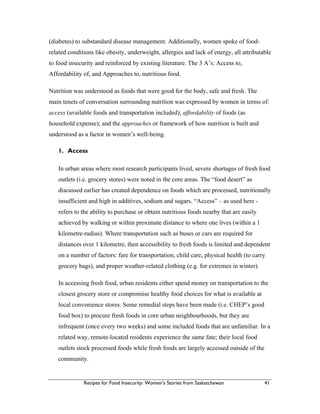
![42 Recipes for Food Insecurity: Women’s Stories from Saskatchewan
In both locations, local convenient stores charge exorbitant prices for basics like
milk. “Stores that are available, the convenient stores - they’re overpriced. Like
milk and stuff is ridiculous – it’s almost $7” (UFG1). Another woman noted that,
“for shopping in our community, our closest grocery store is Extra Foods or GT
(Giant Tiger) and GT is all processed foods. It’s fat – that’s all they give us”
(UFG1).
It has been observed that urban planning within large cities has resulted in
downtown and business-core neighbourhoods supporting few grocery stores but
housing many fast-food outlets, restaurants and corner stores. Supermarkets are not
equally accessible across city regions, with lower access noted in lower-income
areas (Smoyer-Tomic, 2006). Within Saskatoon, the west-side core neighbourhoods,
including Riversdale, has been identified as Saskatoon’s primary food desert. These
neighbourhoods were assessed using indicators of poorest material and social
deprivation scores and poorest food access and highest food imbalance (Kershaw et
al., 2010; Saskatoon Community Clinic, 2008). In addition, living in core Saskatoon
neighbourhoods may involve some additional stresses such as rising rental housing
costs, limited job opportunities, lack of child care facilities and elevated rates of
crime and violence. Those stresses coupled with the potential inability of consuming
nutritious food can lead to compromised health outcomes and increased anxiety,
depression and fatigue as experienced by women through this study.
Food sourced a distance away from the urban participants’ place of residence was
accessed by public transportation (bus), by walking or less often, by car. Most
women took the bus for major shopping days and some women “doubled up” with
other women in this task. “We go together so we can carry the groceries. That way it
doesn’t seem like so much work” (UFG2).
“The majority of us don’t have access to vehicles. [Name] is the only
one who has access to a vehicle. The rest of us walk and we will get our
spaghetti; you don’t get a big bag of flour because we can’t carry that
on our backs. Or potatoes; you can’t buy a 20 pound bag of potatoes if](https://image.slidesharecdn.com/ebe21aec-c139-40fd-bb88-3835a99f64a5-161118194105/85/RecipesForHunger_2011_Hanson-52-320.jpg)
![Recipes for Food Insecurity: Women’s Stories from Saskatchewan 43
you don’t have a way to carry them, so a lot of it is due to accessibility”
(UFG1).
In response to the lack of available food stores in the core neighbourhood of
Riversdale in Saskatoon, a group of individuals and service agencies – like CHEP
and Quint Development - developed plans for a cooperative-run grocery store that
will offer fresh fruit, vegetables, meats, dairy, etc. there. This venture is known as
the Good Food Junction. For one of the participants with the urban community
services focus group, an answer to the access issue of healthy food included more
than simply available food locations.
“I think [why] I am so committed to the Good Food Junction is because
I think it is the issue of access. It’s the issue of access not just to any
food but where you have a store where they know you and where you
can send your kids on their own and know that they are not going to be
taken in a back room and accused of stealing and where you can get
some healthy food and feel part of the community . . . . Kids should not
have to do without healthy foods just because their parents just happen
to not have a lot of money” (CSFG1).](https://image.slidesharecdn.com/ebe21aec-c139-40fd-bb88-3835a99f64a5-161118194105/85/RecipesForHunger_2011_Hanson-53-320.jpg)


![46 Recipes for Food Insecurity: Women’s Stories from Saskatchewan
Women from the study in all three geographies found that the NNFB was
prohibitive based on their current income from low-paying jobs or social assistance
payments and cost of living expenses. As widely noted, food budgets are considered
the most elastic within the overall household budget, therefore subject to
underfunding. Items like rent, mortgage payments, and utility and energy bills are
fixed and therefore paid or budgeted-for before food is purchased or even
considered (PFPP, 2010; Nova Scotia Food Security Network, 2008). One
community service participant commented, “Once rent goes up then there is no
other place for flexibility unless [people] are going to sell their car, except food. So
there isn’t just straight income; it is more complicated than that. It’s the money
that’s available and what gets left for food.” (CSFG1)
Most women commented on the high costs of living and the impossibility of
achieving the recommended NNFB. “For me it’s hard. Sometimes at the end of the
month, before the 21st
of the month, I started to cry because it is hard for me
because I have to pay for my rent and after rent I have to pay for my telephone, for
electricity and when I am finished I have no money in my hands until next month. It
is very hard” (UNCFG).
In Saskatoon, the economic “boom” initiated by trading spikes in provincial
resource stocks (i.e. potash, uranium, oil) in the mid-2000’s had a disastrous effect
on many low to mid-income earners’ household economies. For example, rent for an
average two-bedroom apartment increased rapidly from $609 per month in October
2006 to $935 per month by October 2010 - a 54 per cent increase over three years
(City of Saskatoon, 2011). Vacancy rates in Saskatoon for October 2010 were
modestly improved to 2.6 per cent, after years of severe housing shortages (less than
one per cent) as experienced in the years 2007-2009 (City of Saskatoon, 2011).
Individual income earnings from employment and social assistance did not keep
pace with the sharp increases in household expenditures. Within the context of
insufficient incomes, housing costs were cited as the most prohibitive expense to
food security and housing was most pronounced for urban women.](https://image.slidesharecdn.com/ebe21aec-c139-40fd-bb88-3835a99f64a5-161118194105/85/RecipesForHunger_2011_Hanson-56-320.jpg)
![Recipes for Food Insecurity: Women’s Stories from Saskatchewan 47
“Technically, the income might have been sufficient three years ago and
then with the spike in housing costs and the push to buy a house before it
becomes even more astronomical. That [also] opened the door for landlords
to just double the rents and make no other improvements. And the whole
condo-lization thing just opened up this vile thing . . . .”(CSFG1).
“The rent has a lot to do with it . . . . Because a lot of us, well I'm lucky –
I'm fortunate, but most of the people I know that live in this
neighbourhood are paying more for rent and how much do they have
left after rent, utilities and then grocery money left over? They are
getting paid minimum wage and then they expect us to pay $900 rent
and then we have not even $200 a month left over and it's not even
enough to get groceries for the whole month” (UFG1).
“The Empty Shopping Cart”
© Photovoice Saskatoon project (2006) “Looking out/Looking in: Women, Poverty and Public
Policy” (Saskatoon Antipoverty Coalition and Prairie Women’s Health Centre of Excellence)](https://image.slidesharecdn.com/ebe21aec-c139-40fd-bb88-3835a99f64a5-161118194105/85/RecipesForHunger_2011_Hanson-57-320.jpg)

![Recipes for Food Insecurity: Women’s Stories from Saskatchewan 49
“I’m lucky I have a car and I go to Lloydminister once a month and the
money I save fills my tank with gas. Because I don’t have a lot of food
in my fridge; I’m very tight on my budget. I give myself $150 for food
and that’s for me and my cats. If it weren’t for that money that I save
on gas I would not have gas; I would have to choose food over gas but
I need gas if I want to go to work so it comes out of my food. My car is
old but it gets me to work and back. But it’s only once a month”
(RRFG).
3. Approaches
According to the community service organization CHEP there are diverse
approaches to food security from within its membership. “[Some] would say
poverty right now, but some of them would strongly say health and then there would
be a couple that would talk about the local or environmental side. And then it would
be the skills and knowledge piece on food security” (CSFG2). A similar kind of
diversity exists within Canada’s food movement, where approaches to nutrition,
health, environment and socio-cultural factors come into play in the food discourse.
Nonetheless, many of these approaches are complimentary in nature versus
competing which is a reminder that food should be considered the “tie that binds”.
In approaching the concept of “nutritious food” there was consensus among food
insecure participants that their current diets were insufficient to qualify as healthy.
Access to and affordability of, healthy food was tantamount and women often spoke
of their struggles with either or both of these issues. Nutrition was recognized as a
construct best suited to “expert”; something that was obtained from post-secondary
education. Women felt that the nutrition labels on jars or purchased foods were
difficult to understand without this knowledge. “Good food” or “healthy food” did
not have the same connotations as “nutrition” which was considered an inaccessible,
scientific term for most participants.](https://image.slidesharecdn.com/ebe21aec-c139-40fd-bb88-3835a99f64a5-161118194105/85/RecipesForHunger_2011_Hanson-59-320.jpg)
![50 Recipes for Food Insecurity: Women’s Stories from Saskatchewan
Women seemed curious and eager to enhance skills and knowledge towards the
making of good food through for example, gardening or cooking or an alternative
food market to barter foods, as it was felt they needed to assert more control in their
lives for their own and their children’s health. However, they wondered how they
might garden if they did not own land or frequently moved. Additional concerns
raised were needs for tools, childcare, community and leader support (stressing
interest), and in remote communities, infrastructure to keep dogs and wildlife out of
gardens. Collective kitchens were expressed as an interest area for remote women;
similarly rural women expressed an interest to have an ongoing women’s health
group to learn more about nutrition while having a chance to “get away” from the
responsibilities of family for a few hours. One participant included an interest to see
more local food, in particular organic foods, made affordable for low income
people. In the north, one woman indicated that she was concerned about
environmental contaminants in the meat (duck) people ate as part of their traditional
diets.
“I think our fish are okay except sometimes you hear about the ducks from the
south. I don’t know where they come from, so that’s one concern I have with the
ducks and geese . . . . Some of the ducks are really skinny . . . [and] some have dark
spots in the meat and smell [bad]” (RMFG).
Sometimes, people talked about raising livestock or producing food, considered to
be superior food as it was fresh and wholesome. “My grandparents . . . they had a
farm and horses, chickens, pigs, and everything was fresh. They had milking cows”
(UFG1). The importance of education surrounding food was expressed a number of
times too. “I think in schools it’s important for the younger kids when they are
starting out . . . . He’s not afraid to try new foods now so that was one of the benefits
of taking this cooking class [for him] and just getting to learn some familiar foods”
(UFG1). One participant in the new Canadians focus group offered that Canada
would be well-served by promoting people to farm: “Some of [the people trying to
find a job] could be farmers like they were at their home [countries]. [Our](https://image.slidesharecdn.com/ebe21aec-c139-40fd-bb88-3835a99f64a5-161118194105/85/RecipesForHunger_2011_Hanson-60-320.jpg)
![Recipes for Food Insecurity: Women’s Stories from Saskatchewan 51
government] should encourage and teach them and give them land where they can
cultivate and raise the food” (UNFG).
Understandably, the conversation among community service providers in the rural
area – a mix of ‘farms and oil’ – brought up food production issues and agricultural
policy. A few of the themes in this conversation included: knowledge on food
production and land for growing; agri-food policies that advance corporate interest
over small farmers’; and the lack of vision in food systems.
“We need to be realistic in our planning around food security and
sustainability . . . . Nobody’s working together to really look at what
we can do, especially in Saskatchewan, where we still have those
natural resources. We have the land base to grow an amazing amount
of food and we have farmers working in the oil patch because they
can’t make a living growing food. In one of the last places, like I just
think, why aren’t we doing something to save the amazing wisdom and
knowledge of the growers and hunters and gatherers? . . . There are no
policies in place to protect farmers from those kinds of competitive
agri-business kinds of things. So we can’t expect farmers to save us if
we don’t have a clear plan on how they are going to benefit – why
would they bother doing it? Those are some of the things I see as
challenges in moving forward.”(CSFG2)
While conversation in rural areas dealt more with farm production, discussions also
persisted about the context of food security in women’s lives. Women did not focus
on food security within a nutritional stance pertaining vitamin intake or within a
biomedical framework. Rather food security was a subject as part of a continuum in
women’s health that included social determinants and life choices.
“[Sometimes] I say to myself, I should have [gone] to school; I should
have stayed in school and maybe if I had stayed in school my life would
have been different with my kids. Maybe if I had a job I could afford all](https://image.slidesharecdn.com/ebe21aec-c139-40fd-bb88-3835a99f64a5-161118194105/85/RecipesForHunger_2011_Hanson-61-320.jpg)

![Recipes for Food Insecurity: Women’s Stories from Saskatchewan 53
Conclusion
In Saskatchewan, there is an evident tale of irony at play. In one part of the tale, the
province has a thriving economy based on resource extraction and sales, known in some
circles as “Saskaboom”. In the next chapter of the tale, food bank use in Saskatchewan
saw the second-highest increase in patronage in Canada for 2010. Sadly, a growing
segment of Saskatchewan’s population is affected by this disparity contributing to food
insecurity and unsurprisingly, families with children are most at risk, specifically lone
female-headed families. Aboriginal women who head households with children are
most at-risk of food insecurity, speaking to inequitable opportunities for women in
accessing higher education, employment, political leadership, and affordable housing.
Some might wonder in these tales how a province which upheld agricultural interests to
“feed the world” and that created medi-care as a platform for health equity, now writes
its stories.
According to Roppel, Desmaris and Martz (2006), Canadian agricultural policy shifted
in the 1990s to adopt a “neo-liberal development approach that emphasize[d] an
unrestricted [global] market, rather than the state as regulator of the economy and
society” (p.2). The disadvantaged role of family farm was quickly co-opted in this
approach, forcing thousands from rural areas to ‘sink or swim’ in a new era of
industrialized farming.
As food is the product of agriculture, new policies that aim to address food security
need to address how food is produced, marketed and distributed. And because food and
food production is so firmly planted in human and planetary health, how we orient food
policies need to incorporate an inter-disciplinary approach that include environment,
socio-cultural, and equitable economic considerations. And lastly, as Van Esterick
(1999) asserts, “in order to realize . . . food security, women’s food experiences need to
inform both food policy and global food regimes” (p.231).](https://image.slidesharecdn.com/ebe21aec-c139-40fd-bb88-3835a99f64a5-161118194105/85/RecipesForHunger_2011_Hanson-63-320.jpg)








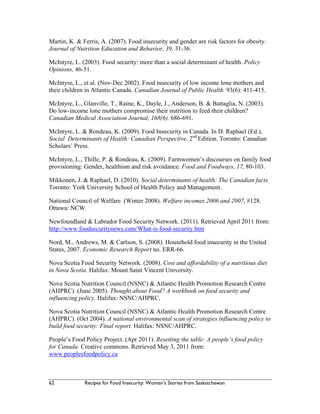

![64 Recipes for Food Insecurity: Women’s Stories from Saskatchewan
Smoyer-Tomic, K., Spence, J. & Amrhein, C. (2006). Food deserts in the Prairies?
Supermarket accessibility and neighborhood needs in Edmonton, Canada. The
Professional Geographer, 58(3), 307-326.
Social Policy Research Unit (SPRU). (2006). November 2006 report card on child
poverty in Saskatchewan. University of Regina: Social Policy Research Unit.
Sommer, A. (1995). Vitamin a Deficiency and Its Consequences: A Field Guide to
Detection and Control. Geneva: World Health Organization.
Statistics Canada 2006. (2006). 2006 Community Profiles. Statistics Canada. Retrieved
August, 2010 from: http://www12.statcan.ca/census-recensement/2006/dp-pd/prof/92-
591/details/page.cfm?Lang=E&Geo1=HR&Code1=4706&Geo2=PR&Code2=47&Data
=Count&SearchText=Saskatoon%20Regional%20Health%20Authority&SearchType=
Begins&SearchPR=01&B1=All&GeoLevel=PR&GeoCode=4706
Tarasuk, V. & Beaton, G. (2009). Women’s dietary intakes in the context of household
food insecurity. Journal of Nutrition, 129: 672-679.
Tarasuk, V. , McIntyre, L. & Li, J. (2007). Low-income women’s dietary intakes are
sensitive to the depletion of household resources in one month. Journal of Nutrition.
137: 1980-1987.
Tayie, F. & Zizza, C. (2009). Height differences and the associations between food
insecurity, percentage body fat and BMI among men and women. Public Health
Nutrition, 12(10): 1855-1861.
Townsend, M., Peerson, J., Love, B., Achterberg, C. & Murphy, S. (2001). Food
insecurity is positively related to overweight in women. Journal of Nutrition, 131:
1738-1745.
Van Esterick, P. (1999). Right to food; right to feed; right to be fed. The intersections of
women’s rights and the right to food. Agriculture and Human Values. 16:225-232.
Vozoris, N. & Tarasuk, V. (2003). Household food insufficiency is associated with
poorer health. Journal of Nutrition, 133, 120-126.
Wekerle, G.R. (2005). Domesticating the neoliberal city: Invisible genders and the
politics of place. In Harcourt, W. & Escobar, A. Women and the politics of place.
Bloomfield, CT: Kumarian Press Inc.
Willows, N., Veugelers, P., Raine, K. & Kuhle, S. (May 2011). Associations between
household food insecurity and health outcomes in the Aboriginal population (excluding
reserves). Ottawa: Statistics Canada. Health reports, 22(2). [82-003-XPE]
Woods, F. (2003). Access to food in Saskatoon’s core neighborhood. Saskatoon:
Community University Institute for Social Research, University of Saskatchewan.](https://image.slidesharecdn.com/ebe21aec-c139-40fd-bb88-3835a99f64a5-161118194105/85/RecipesForHunger_2011_Hanson-74-320.jpg)